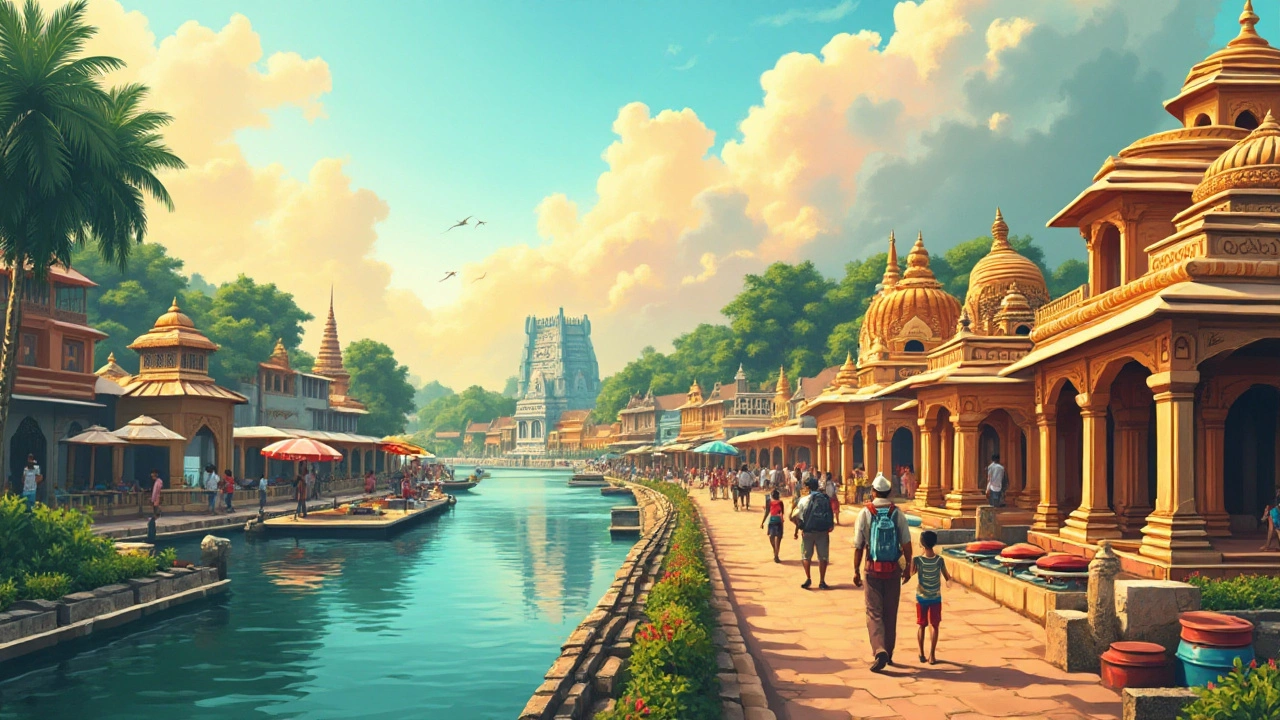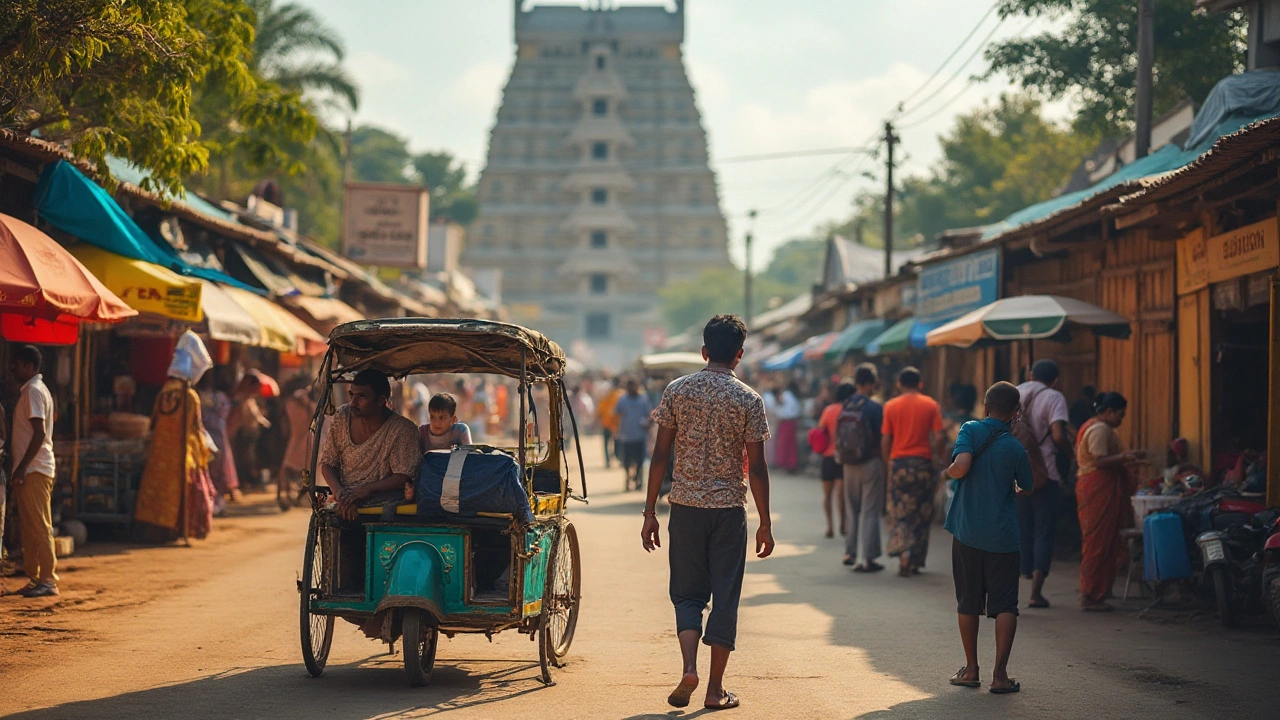Affordable South India Travel: Budgeting Your Trip Costs
 Feb, 2 2025
Feb, 2 2025
South India, a region teeming with cultural richness and natural beauty, offers travelers a mosaic of experiences waiting to be discovered. But before setting foot on its vibrant soil, one pressing question often arises: How much does it cost to journey through this captivating land?
Deciphering the expenses of a South Indian adventure involves looking into various elements like transportation, stays, dining, and excursions. In this guide, we aim to unravel these components to help you chart out a budget-conscious expedition that maximizes your travel joys. From savoring aromatic spices in local eateries to exploring ancient temples or cruising along Kerala's famed backwaters, South India delivers diverse experiences that cater to a spectrum of budgets. Let's embark on a detailed exploration of what it takes financially to make your South Indian dreams a reality.
- Transportation Costs
- Accommodation Options
- Dining and Food Expenses
- Sightseeing and Activities
- Travel Tips and Cost-Saving Advice
Transportation Costs
One of the first considerations for any traveler planning a trip to South India is transportation. The region, with its mix of bustling cities and serene landscapes, offers a variety of options to suit different budgets and travel preferences. Whether you're traversing the lush landscapes of Kerala or the historical magnificence of Tamil Nadu, getting around doesn't have to drain your wallet. The two main types of transportation you'll likely use are domestic flights and ground transportation, including trains, buses, and taxis.
Domestic flights in India are a popular and efficient way to cover large distances quickly, especially given the extensive network of airports across the country. Carriers like IndiGo, SpiceJet, and Air India frequently offer competitive rates, especially if you book in advance. A flight from Mumbai to Chennai, for example, might range from INR 3,000 to INR 6,000 (approximately CAD 50 to CAD 100) depending on how early you book and the season of travel. It's worth noting that prices tend to rise during peak season, so reserving your tickets a few months ahead is advisable. A good pro tip here is to set alerts on travel sites, so you don’t miss out on flash sales that can pop up unexpectedly.
On the ground, South India is well-connected by an efficient rail network that offers a more scenic and immersive journey. Indian Railways can be both economical and comfortable if you choose the right class. Sleeper classes on inter-city trains are cost-effective, while the air-conditioned 3-tier (3AC) option provides comfort at a reasonable cost, with large windows perfect for watching the landscape slide by. For instance, a train journey from Bengaluru to Kochi can cost around INR 1,200 (approximately CAD 20) in 3AC, providing excellent value for money. Booking tickets through the official IRCTC website or app ensures secure reservations. For those seeking an authentic experience, second-class seating, while basic, is the way to mingle with locals and soak up the culture.
Local buses, especially government-run services in states like Kerala and Karnataka, offer the most budget-friendly option for shorter distances. These buses are well-suited to urban areas and nearby towns, although they can be crowded. Private bus operators, such as KSRTC in Karnataka, provide comfortable sleeper and semi-sleeper coaches on inter-state routes. Expect to spend about INR 500 to INR 800 (CAD 8 to CAD 13) for longer journeys by private bus. While taxis and ride-sharing services like Ola and Uber are more expensive, they offer convenience and flexibility, especially in urban centers. Renting a private car with a driver might be slightly pricier but provides freedom and comfort, especially for families or small groups.
Travelers interested in exploring towns off the beaten path or experiencing India travel budget options should consider hiring two-wheelers or bicycles. In tourist-heavy areas like Goa, renting a scooter can cost as little as INR 400 per day (about CAD 7) and offers a liberating way to explore the beach-lined coast or green-clad hills at your own pace. However, it’s important to exercise caution since traffic conditions can be challenging, and an international driving permit is required to rent motor vehicles legally.
As the esteemed Indian travel writer Shoba Narayan aptly puts it, "Traveling through South India is as much about the journey as the destination. Each road, each path offers a story that sticks." Indeed, whether by flight, train, bus, or bike, each mode of travel provides unique insights and perspectives on this fascinating corner of the world.
Access to affordable transport options in South India means travelers can allocate more of their budgets to unforgettable experiences without worrying excessively about moving from place to place. By planning carefully and exploring different options, it's possible to travel comfortably and economically, allowing you to absorb all the sights, sounds, and flavors that South India has to offer.
Accommodation Options
Exploring South India is a journey that offers an array of choices when it comes to where you'll rest your head. The region stands as a vibrant tapestry of accommodation options, catering to every kind of traveler, from the budget-conscious backpacker to the luxury-seeking vacationer. A vital aspect of your planning process should be choosing accommodations that fit your itinerary, comfort preferences, and budget. Thankfully, South India doesn't disappoint with its myriad offerings.
For travelers looking to save on costs while enjoying a genuine local experience, guesthouses and homestays are a fantastic option. These provide not only affordable lodging but also the opportunity to immerse oneself in the local culture and lifestyle. Friendly hosts often go the extra mile, offering home-cooked meals and insightful advice on hidden gems in the vicinity. In bustling cities like Chennai and Bangalore, you can find comfortable and clean guesthouses for as low as ₹700 per night, making them perfect for budget travelers.
Mid-Range Accommodations
If you have a bit more flexibility in your budget, consider the mid-range hotels and resorts dotting the lush landscapes and coastal lines of states like Kerala and Karnataka. These accommodations typically range from ₹1,500 to ₹4,000 per night and often come with additional amenities such as swimming pools, in-house dining, and guided tours. An average mid-range hotel in a city such as Cochin might offer you not just comfortable rooms, but also a perfect balance between modern conveniences and rustic charm.
"South India’s hospitality industry offers something for everyone, ensuring each traveler's journey is as comfortable as it is memorable," notes Travel India Magazine.
Luxury Stays
For those seeking an indulgent escape, the luxury hotels and heritage resorts in South India reimagine opulence. Sanctuaries of splendor like the Taj Hotels or CGH Earth properties provide unparalleled services, often set against breathtaking backdrops such as the serene backwaters or majestic hill stations. These range from ₹10,000 upwards per night but offer unmatched experiences, from spa treatments drawing on ancient Ayurvedic traditions to gourmet dining experiences featuring the rich tapestry of South Indian culinary arts.
As an interesting insight, South India also offers unique accommodation in traditional houseboats known as kettuvallam, particularly in the serene backwaters of Kerala. Renting a houseboat can vary drastically in price and luxury, ranging from simple one-bedroom boats to lavish floating palaces, and starting from ₹6,000 per night. A stay in one of these boats offers an intimate glimpse at the tranquil life revolving around these water arteries.
Whether you choose a breezy beachside villa in Goa, a heritage homestay on a coffee plantation, or an eco-friendly resort overlooking the Nilgiris, your South Indian sojourn will be enriched by the comfort and hospitality experienced along the journey. Keep in mind the peak travel seasons and festivals can cause a spike in prices, so booking in advance is always a wise strategy to secure the best deals.

Dining and Food Expenses
When you think about a South India trip cost, dining is one aspect that offers a delightful balance between affordability and deliciousness. The culinary landscape is as diverse as the region itself, ranging from spicy Andhra cuisine to the coconut-infused flavors of Kerala. Most travelers find themselves enamored with the street food that South India offers. Typical meals at local eateries, known as 'tiffin centers,' could set you back as little as INR 50 to 150 ($0.60 to $1.80 USD) for a filling plate of dosas, idlis, or vadas served with a variety of chutneys and sambar. For those who prefer dining in more established restaurants, a meal could range between INR 200 to 500 ($2.50 to $6 USD), still very budget-friendly when compared to Western standards.
The experience of dining in South India isn't just about the food, but about immersing oneself in traditions that have been passed down for generations. Take the traditional banana leaf meal for instance, which offers an array of dishes including curries, pickles, and sweets all expertly placed upon a large banana leaf. This is not just a meal; it's an event that locals cherish and tourists remember long after the journey has ended. Vegetarian options are abundant and often, these meals are served in a 'thali' style — filling and cost-effective, ideal for budget-conscious travelers.
For those inclined towards more premium dining experiences, South Indian fine dining restaurants offer a modern twist on classic dishes. While these can be pricier, costing upwards of INR 1,000 ($12 USD) per person, the culinary artistry experienced here provides value well worth the price. A visit to places like Bengaluru or Chennai showcases numerous establishments offering such experiences, melding traditional flavors with global influences.
CNN Travel states, "South Indian cuisine, with its emphasis on millets and lentils, forms the bedrock of the region's diet, a vast and colorful expanse brimming with history and hospitality."
Interestingly, beach shacks line the shores in Goa, serving fresh seafood resulting in a meal set you might find in a coastal town. Prices here range remarkably, from INR 300 to 800 ($4 to $10 USD), offering fresh prawns, crabs, and fish. It’s a perfect blend for those craving fresh, ocean-side dining without splurging excessively. To top it off, tipping isn't obligatory in South India, but a 5-10% gratuity is always appreciated if you receive exceptional service.
While crafting your India travel budget, understanding the varied culinary options in South India is key. Whether you’re seated at a humble street-side stall or a plush urban restaurant, the flavors you encounter here promise to be enchanting, all the while providing a myriad of choices that proficiently fit into a South India itinerary.”
Sightseeing and Activities
Venturing into the heart of South India means immersing yourself in a kaleidoscope of history, culture, and natural wonders. The region is a tapestry of sacred temples, lush landscapes, bustling bazaars, and serene beaches, each offering a unique slice of the subcontinent's vibrant tapestry. Starting your journey in the ancient city of Mysore, renowned for its grand Mysore Palace, you will be transported back in time to witness the opulence of yesteryears. The weekly illumination of the palace with thousands of bulbs is a sight to behold, capturing the imagination of every visitor. Not far from Mysore lies the lush expanse of Coorg, where coffee plantations stretch as far as the eye can see, and the aroma of freshly brewed coffee fills the air. Exploring these plantations is a must for any traveler looking to delve deeper into the local culture and traditions.
The state of Tamil Nadu is home to some of India's most revered temples, including the towering Brihadeeswarar Temple in Thanjavur. This UNESCO World Heritage Site is a marvel of Dravidian architecture, with its intricate carvings and imposing Gopuram drawing in visitors from around the globe. The spiritual aura of these sacred sites provides a glimpse into the ancient customs that continue to thrive in this part of the world. Moving to Kerala, often dubbed 'God's Own Country,' you're greeted by the tranquil backwaters of Alleppey. A houseboat cruise here is a blissful experience, with lush greenery and traditional villages offering a window into life along the languid waterways.
For those seeking adventure, the Western Ghats offer ample opportunities for trekking and wildlife spotting. Estates like Munnar and its sprawling tea gardens beckon hikers with trails that meander through mist-soaked hills. The Eravikulam National Park is another jewel, providing a sanctuary for the endangered Nilgiri Tahr. The park's rolling grasslands and the chance to spot this rare mountain goat make for an unforgettable trek. Whether you're a history buff, nature enthusiast, or spiritual seeker, South India caters to all, ensuring a rich array of activities that resonate long after the journey ends.
As Mark Twain once reflected on his travels through India,
"India is the cradle of the human race, the birthplace of human speech, the mother of history, the grandmother of legend, and the great grandmother of tradition."A sojourn through South India undoubtedly echoes this sentiment, leaving travelers with a deeper appreciation for its enduring legacy.

Travel Tips and Cost-Saving Advice
Embarking on a journey across South India doesn't mean you need to drain your savings. With a few strategic moves, you can stretch your budget while still diving deep into the culture, flavors, and sights this region has to offer. First, consider traveling during the shoulder season, which lies between the monsoon dampened retreats of June to September and the tourist-heavy months of December and January. Visiting during this time not only spares you from dense crowds, but it also opens up opportunities for lower rates on accommodations and flights. The weather, being mild and pleasant, is an added bonus for river cruising or temple hopping without the impending rush.
Accommodation is another area where you can significantly save. Opt for homestays or guesthouses over luxury hotels to cut down expenses and enrich your journey with local stories and homemade meals. Platforms like Airbnb or local services like Oyo Rooms have a myriad of budget-friendly options. Noteworthy, many towns and villages have unique heritage houses that have been converted into guesthouses, providing not just a place to sleep but a story to tell at an affordable price.
When it comes to dining, South India's street food is both a culinary adventure and a wallet-friendly choice. From Mumbai's famed vada pav to Tamil Nadu's flavorful dosas, choosing local eateries over restaurants gives you an authentic experience at a fraction of the cost. Be sure to indulge in banana leaf meals found at mess halls that welcome you with generous portions and wallet-friendly prices. Another insider tip: carry a reusable water bottle. Several public places and restaurants offer water refilling stations. Not only does this save money on bottled water, but it's also an environmentally friendly alternative.
For transportation, India's rail network remains one of the most economical modes of transport. The South India itinerary is best explored by trains where tickets offer air-conditioned cabins and the chance to meet friendly locals. Purchasing tickets well in advance on the Indian Railway's official site or app can secure great deals. Local buses and shared autos, called tuk-tuks, offer yet another way to explore without spending too much. Don't shy away from negotiating fares for autorickshaws, as prices are often flexible, and polite persistence can lead to fairer rates.
On the topic of sightseeing, many attractions, especially temple complexes, remain free to enter while offering volunteer-led tours with insightful narratives about history and culture. For parks and wildlife sanctuaries, consider guided group tours rather than private ones; not only are they budget-friendly, but they also foster a sense of community among travelers. One avid traveler, Ravi Sundaram, once noted, "Budgeting allowed me to immerse myself deep into the cultural tapestry without the constant worry of overspending."
In essence, South India welcomes travelers with open arms, offering something for every budget. With just a bit of research and strategic planning, you can savor this vibrant region in all its glory without feeling financially strained.